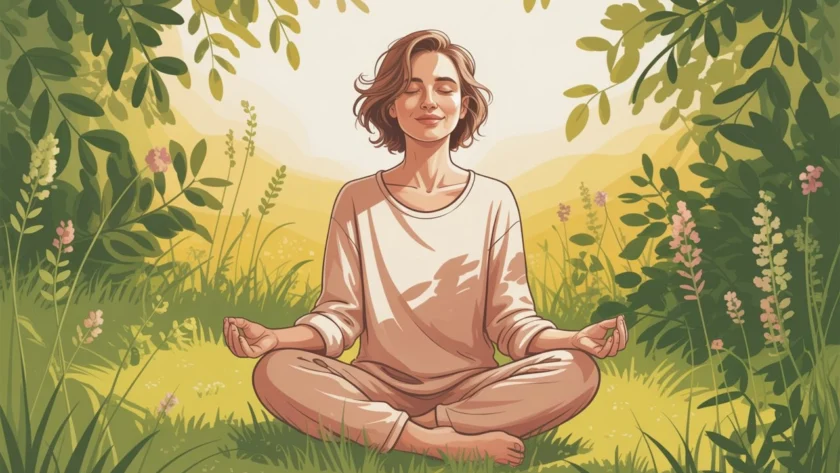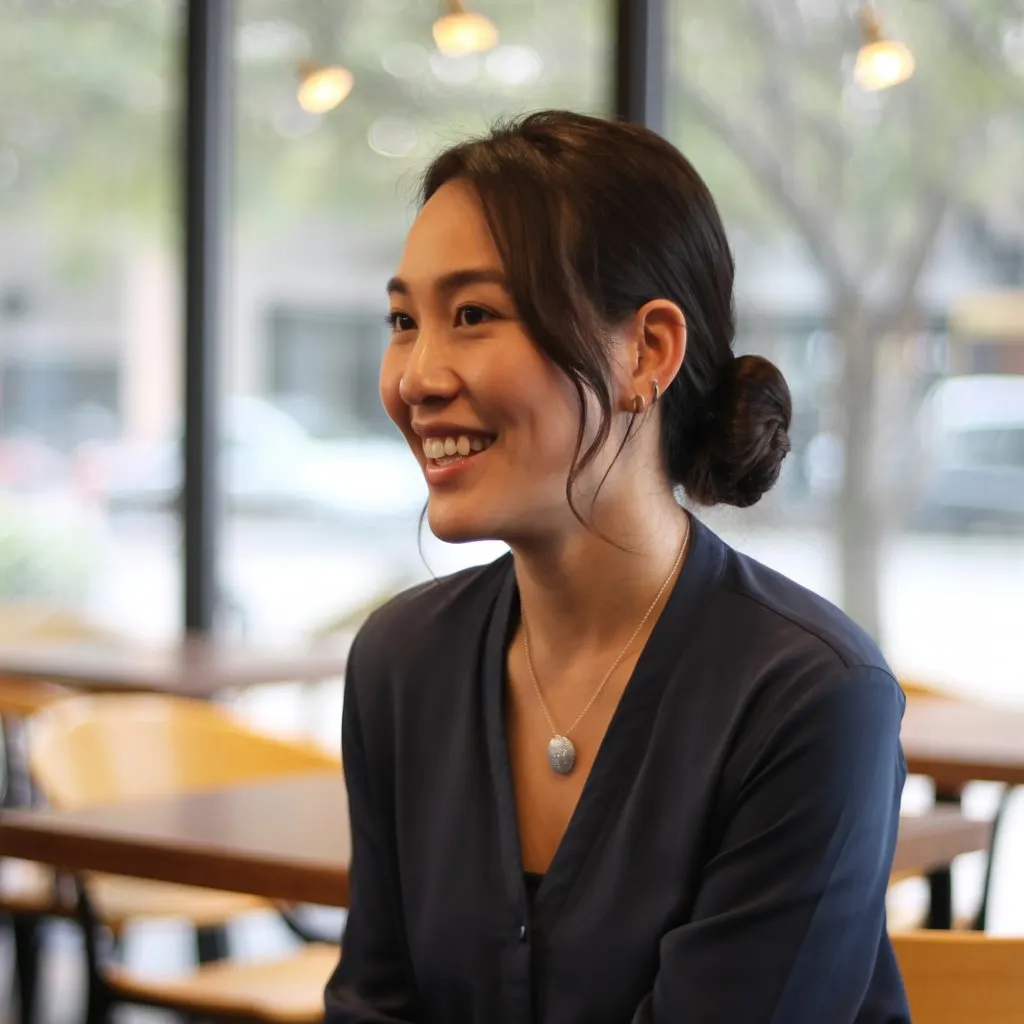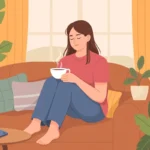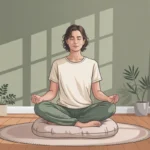I’ll never forget the winter I spent mostly indoors, buried under deadlines and anxiety that felt like a weighted blanket I couldn’t shake off. My counselor asked me a simple question during one session: “Amelia, when was the last time you actually went outside and felt the sun on your face?” I couldn’t remember. That conversation opened my eyes to something I’d been missing—literally missing the light that my body and soul desperately needed.
Here’s what I’ve come to understand through my own journey and years of helping others: sometimes the simplest solutions are the ones we overlook. We’re so focused on managing our racing thoughts and pounding hearts that we forget our bodies need basic things to function well. And one of those fundamental needs? Sunlight and the vitamin D it helps create.
Now, I’m not saying a walk in the sunshine will cure anxiety—I wish it were that simple. But what I’ve discovered is that getting adequate vitamin D is like laying a foundation for better mental health. Without it, everything else you’re doing to manage anxiety becomes harder.
Why Sunlight and Vitamin D Matter for Anxiety
Let me share something that fascinated me when I first learned about it. Vitamin D isn’t just a vitamin—it’s actually a hormone that affects nearly every system in your body, including your brain. And when you’re low on it, your brain struggles to produce the neurotransmitters that help regulate your mood and keep anxiety in check.
I’ve seen this pattern over and over, both in my own life and in conversations with readers. Someone reaches out about their worsening anxiety, and when we dig deeper, they mention they rarely go outside, or they live in a northern climate during winter months, or they’re spending twelve-hour days in an office with no natural light. It’s like trying to grow a plant in a closet and wondering why it’s wilting.
The connection between vitamin D and anxiety isn’t just something I’ve observed personally. The research backs this up too, though I prefer to talk about what I’ve actually witnessed. When your vitamin D levels are adequate, your brain can better produce serotonin—that feel-good neurotransmitter that helps you feel calm and balanced. Without enough vitamin D, it’s like your brain is trying to play a symphony with missing instruments.
The Spiritual Side of Sunlight
Here’s something beautiful I’ve noticed: God designed our bodies to need the light. There’s something almost poetic about that, isn’t there? Throughout Scripture, light represents hope, healing, and God’s presence. “The Lord is my light and my salvation—whom shall I fear?” (Psalm 27:1). While David was speaking spiritually, I don’t think it’s a coincidence that our physical bodies also crave light for healing.
I’ve come to see my morning time in the sunshine as a spiritual practice. When I step outside with my coffee and let the sun warm my face, I’m not just getting vitamin D—I’m remembering that God created this incredible world with intention. He knew we’d need light. He knew our bodies would respond to it. That awareness turns a simple health practice into a moment of gratitude and connection with Him.
How Vitamin D Deficiency Fuels Anxiety
Let me get real with you for a moment. During that dark winter I mentioned, I was also dealing with what I thought was just worsening anxiety. My heart would race for no reason. I felt irritable and on edge. Sleep became difficult, and I’d wake up feeling exhausted no matter how long I stayed in bed. My doctor ran some routine blood work, and guess what showed up? My vitamin D levels were in the basement.
When someone’s vitamin D is low, it creates this perfect storm for anxiety to thrive. Your brain fog gets worse, making it harder to challenge anxious thoughts. Your energy plummets, so you withdraw from activities and people that normally help you feel better. Your sleep suffers, and we all know what sleep deprivation does to anxiety levels. It’s like dominoes falling, one after another.
What I wish someone had told me years ago is that anxiety doesn’t just live in your mind—it lives in your body too. And your body needs certain building blocks to maintain emotional balance. Vitamin D is one of those critical building blocks that too many of us are missing.
Signs You Might Be Low on Vitamin D
I’ve learned to pay attention to my body’s signals now, and I encourage you to do the same. Some signs that low vitamin D might be contributing to your anxiety include:
Persistent fatigue that doesn’t improve with rest. I remember feeling bone-tired all the time, like I was carrying extra weight that no one else could see.
Increased anxiety or panic attacks, especially during winter months. There’s a reason seasonal patterns matter—when the days get shorter and the sun disappears, our vitamin D production plummets.
Difficulty concentrating or that frustrating brain fog that makes everything feel harder than it should be.
Muscle aches or bone pain that doctors can’t quite explain. Your bones need vitamin D to stay healthy, and when they’re not getting enough, they let you know.
Frequent illness or a weakened immune system. When you’re constantly fighting off colds or infections, it’s harder for your body to manage stress and anxiety effectively.
Natural Ways to Increase Vitamin D Through Sunlight
Here’s what I’ve come to love about sunlight as a natural anxiety relief tool: it’s free, it’s accessible, and it comes with bonus benefits like fresh air and a chance to step away from our screens. But there’s an art to getting sunlight right, especially if you’re dealing with anxiety.
The Morning Sunshine Routine
I’ve developed what I call my “sunrise practice,” and it’s become one of the most grounding parts of my day. Within an hour of waking up, I step outside—even if it’s just for ten minutes. I don’t bring my phone. I don’t listen to podcasts. I just stand there with my coffee, feel the sun on my face, and talk to God about the day ahead.
Those morning rays do something special. They help reset your circadian rhythm, which is crucial for managing anxiety. When your body knows when it’s supposed to be awake and when it’s time to rest, everything else starts to settle into place. Plus, morning sunlight tends to be gentler, so you’re less likely to burn while still getting good vitamin D production.
If you’re thinking, “But I’m not a morning person,” I hear you. I wasn’t either. Start with just five minutes. Stand on your porch or balcony. Sit on your front steps. The goal isn’t to become someone you’re not—it’s to give your body what it needs to support your mental health.
How Much Sun Exposure Do You Really Need?
This is where it gets personal, because everyone’s needs are different. I’ve found that I need about 15-20 minutes of midday sun on my arms and legs, three to four times a week, to maintain healthy vitamin D levels. But your needs might be different based on your skin tone, where you live, and the season.
People with darker skin need more sun exposure to produce the same amount of vitamin D as those with lighter skin. If you live in northern latitudes or it’s winter, the sun’s angle makes it harder for your skin to produce vitamin D, even when you’re outside. And if you’re older, your skin isn’t as efficient at making vitamin D as it used to be.
Here’s my practical approach: aim for moderate sun exposure before you’d start to burn. That might be 10 minutes for fair-skinned folks, or 30 minutes for those with darker skin. You want to expose your arms, legs, and face when possible—not just your hands while you’re driving.
Making It Work with Real Life
I know what you’re thinking: “Amelia, I work in an office all day. How am I supposed to get sunshine?” Trust me, I’ve been there. Here are some strategies that have worked for me and others I’ve coached:
Take your lunch break outside, even if it’s just eating a sandwich on a bench. Those 20 minutes add up.
Park farther away from the entrance and walk through a sunny area instead of the covered parking structure.
Schedule walking meetings when you can. I’ve had some of my best conversations while walking outdoors with colleagues or friends.
Use your weekends strategically. If you’re stuck inside all week, make sunshine a priority on Saturday and Sunday. Go to the farmer’s market. Take a morning hike. Garden in your yard. Make it count.
Boosting Vitamin D Through Diet
While sunlight is the most natural way to get vitamin D, sometimes we need backup support, especially during those long winter months when the sun seems to disappear for weeks at a time. I’ve learned to think of food as another tool in my anxiety-management toolkit.
Vitamin D-Rich Foods That Actually Taste Good
Let me be honest—when I first learned about vitamin D foods, I wasn’t excited. Fatty fish? Egg yolks? I’m a Texas girl who grew up on comfort food, not exactly a seafood enthusiast. But I’ve found ways to incorporate these foods that don’t feel like a chore.
Salmon has become my go-to. I grill it with lemon and herbs, or make salmon patties that remind me of the tuna patties my grandmother used to make. Just three ounces gives you nearly a full day’s worth of vitamin D. If fresh salmon feels too expensive, canned salmon works just as well and costs a fraction of the price.
Egg yolks are probably the easiest addition. I scramble eggs with vegetables for breakfast, or make a veggie-packed frittata on Sunday that I can eat throughout the week. Each yolk has a small amount of vitamin D, but it adds up when you’re eating them regularly.
Fortified foods have been a game-changer for me. Most milk alternatives are fortified with vitamin D, which is helpful since I’ve cut back on dairy. Orange juice, certain cereals, and yogurt often have added vitamin D too. I check labels now, something I never used to do.
Mushrooms are the only plant source of vitamin D, especially when they’ve been exposed to UV light. I’ve started buying mushrooms marketed as “UV-treated” or just leaving regular mushrooms in the sun for a few hours before cooking them. It sounds odd, but it works.
Creating Meals That Support Your Mental Health
What I’ve discovered is that eating for better vitamin D levels doesn’t have to be complicated or expensive. I make a big breakfast scramble on weekends with eggs, mushrooms, and whatever vegetables I have on hand. During the week, I keep it simple with yogurt and fortified cereal. For dinner, I try to include fatty fish once or twice a week.
The key is making it sustainable. If you hate fish, don’t force yourself to eat it every day. Find the vitamin D sources you actually enjoy, and build from there. Your anxiety management plan should reduce stress, not create more of it.
When Supplementation Makes Sense
Now we’re getting to something I resisted for a long time. I wanted to do everything “naturally,” and taking supplements felt like admitting defeat somehow. But here’s what shifted my perspective: if your body needs something it’s not getting, giving it that support isn’t weakness—it’s wisdom.
My Journey with Vitamin D Supplements
After that winter when my levels tanked, my doctor recommended I start taking vitamin D3 supplements. I was skeptical at first, but within a few weeks, I noticed subtle changes. My energy improved. The heavy fog that had settled over my thoughts started to lift. My sleep got better, which meant my anxiety had less ammunition to work with.
I take 2,000 IU daily now, usually with breakfast since vitamin D is fat-soluble and absorbs better with food. During winter months, I sometimes increase to 3,000 IU with my doctor’s guidance. Everyone’s needs are different, which is why I always recommend getting your levels tested before starting supplements.
Choosing the Right Supplement
Here’s what I’ve learned about vitamin D supplements: D3 (cholecalciferol) is more effective than D2 (ergocalciferol) at raising your blood levels. Look for D3 specifically.
I prefer supplements that also include vitamin K2, which helps your body use the vitamin D properly. And since vitamin D is fat-soluble, taking it with a meal that contains some healthy fats—like eggs, avocado, or nuts—helps your body absorb it better.
Quality matters too. I look for third-party tested supplements, which means an independent lab has verified what’s actually in the bottle matches what’s on the label. It costs a bit more, but it’s worth it for peace of mind.
Working with Your Healthcare Provider
This is important, and I can’t stress it enough: talk to your doctor before starting supplements, especially if you’re taking other medications or have health conditions. Too much vitamin D can cause problems, just like too little can. I get my levels checked once or twice a year to make sure I’m in the sweet spot—not too low, not too high.
When I first started advocating for vitamin D testing, my doctor wasn’t convinced it was necessary. I had to be persistent, explaining how my symptoms lined up with deficiency and asking for the test as part of my comprehensive anxiety treatment plan. Don’t be afraid to advocate for yourself. You know your body better than anyone else.
Combining Sunlight, Diet, and Faith Practices
What I love most about addressing vitamin D deficiency is how naturally it fits into a holistic approach to anxiety relief. It’s not just about popping a pill or forcing yourself to sit in the sun—it’s about creating rhythms and practices that nurture both body and spirit.
My Integrated Approach
These days, my morning sunshine time has become prayer time. I step outside, feel the warmth on my face, and thank God for another day. I pray about my worries, yes, but I also just breathe and notice the world He created. The birds singing. The way the light filters through the trees. My dog Bailey sniffing around the yard with pure joy.
This practice does multiple things at once: I’m getting vitamin D from the sun, I’m connecting with God through prayer, and I’m grounding myself in the present moment instead of spiraling into anxious thoughts about the day ahead. It’s efficient and healing all at once.
When I eat my vitamin D-rich breakfast, I’ve started saying a more intentional blessing over my food. Not just a quick “bless this food,” but real gratitude for how God designed our bodies to need certain nutrients, and how He provided those nutrients in foods we can access and enjoy. It transforms a mundane meal into an act of worship and self-care.
The Bigger Picture of Natural Anxiety Relief
Here’s what I want you to understand: vitamin D is just one piece of the puzzle. It’s an important piece, absolutely, but it works best when combined with other natural anxiety relief strategies—things like regular movement, good sleep, strong relationships, spiritual practices, and sometimes professional help.
I think of it like building a house. Vitamin D is part of the foundation. If your foundation is crumbling, everything else you try to build on top of it will be shaky. But once that foundation is solid, the other practices and strategies you’re using become so much more effective.
Overcoming Common Obstacles
Let me address some real challenges I’ve faced and heard from others, because knowing what to do is one thing—actually doing it is another.
“I’m Too Anxious to Go Outside”
I’ve been there. There were weeks when even checking the mail felt overwhelming, much less going for a walk. If this is you, start impossibly small. Open your curtains and sit by the window. Stand on your porch for two minutes. Sit in your car with the window down. You don’t have to go for a hike or make a big production of it.
Ask someone to go with you if that helps. My friend Sarah used to text me every morning, and we’d both commit to stepping outside for just five minutes. Having that accountability made it easier on days when anxiety was trying to keep me isolated.
“I Live Where There’s Not Much Sun”
I hear this from readers in places like Seattle or Minnesota, where winter means months of gray skies. This is where supplementation becomes even more important. You can’t rely on sun exposure alone if the sun barely shows up for half the year.
But don’t give up on getting outside, even when it’s cloudy. You still get some UV exposure on overcast days, and the fresh air and change of scenery help with anxiety in other ways. Bundle up, brave the cold for even 10 minutes, and then come back inside to your cozy space. The contrast actually feels good.
“I Work Night Shifts”
This is tough, and I won’t pretend otherwise. If your schedule means you’re sleeping during daylight hours, you’ll need to be more intentional about supplementation and diet. Talk to your doctor about higher doses of vitamin D3 to compensate for the lack of sun exposure.
On your days off, prioritize getting outside during daylight hours. Your body’s circadian rhythm is already disrupted from shift work, so every bit of natural light exposure you can get helps minimize the impact on your mental health.
Moving Forward with Hope and Intention
As I finish writing this with my own coffee cup empty and Bailey asleep at my feet, I’m reminded of how far I’ve come. That winter when I barely left the house feels like a lifetime ago. It wasn’t just one thing that helped me heal—it was a combination of many small, consistent choices. Getting adequate vitamin D was one of those choices.
You don’t have to overhaul your entire life tomorrow. You don’t have to do everything perfectly. But you can start somewhere. Maybe it’s getting your vitamin D levels tested. Maybe it’s committing to five minutes of morning sunshine. Maybe it’s adding eggs to your breakfast routine or picking up a quality supplement.
Whatever your starting point, know that you’re not alone in this journey. God sees your struggle with anxiety. He created your body with specific needs, and meeting those needs isn’t shallow or unspiritual—it’s honoring the way you were designed.
“The light shines in the darkness, and the darkness has not overcome it” (John 1:5). Sometimes that light is spiritual truth breaking into our anxious thoughts. And sometimes, quite literally, it’s the sunshine that helps our bodies produce what we need to feel more like ourselves again.
Take it one day at a time. Step outside when you can. Eat well when possible. Consider supplements if needed. And through it all, remember that caring for your physical body is one way of caring for your soul. They’re not separate—they’re beautifully, intricately connected.
Your anxiety doesn’t have to have the final word. With God’s help, the right support, and simple practices like getting adequate vitamin D, you can find more peace than you might think possible right now. I’ve seen it happen over and over—in my own life and in the lives of so many others.
The light is there. Step into it, friend. Your body and your spirit will thank you.




